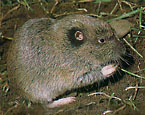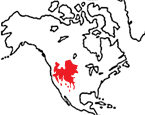|
Northern Pocket
Gopher
(Thomomys talpoides) #59-163 |
||||
|
|
Physical
characteristics and distribution
|
|
Head and body length of T. talpoides is between 115-305
mm, tail length is 40-95 mm. Weights range from 45-545 grams.
The soft, short fur is nearly uniform in color and covers the
entire body, except for the tip of the tail. Variations of color
are from almost black, gray, brown and almost white. Underparts
are only slightly lighter. The body is robust with short legs.
The eyes and ears are small, and unlike most other geomydes,
the incisors of Thomomys usually lack frontal grooves.
T. talpoides has long front claws, enabling it to dig
an extensive system of burrows consisting of deep permanent
galleries and shallow feeding tunnels. Their
diet consists of roots, bulbs, leaves, cultivated crops, and
other vegetation. If possible, they will burrow beneath a plant,
chew off the roots and pull it through the ground by the stem.
Food is cut into small pieces and stored in the fur lined cheek
pouches for transportation. Pocket gophers do not drink water,
apparently getting sufficient moisture from the vegetable matter.
|
|
Description
of the brain
|
|
Animal
source and preparation
|
|
All
specimens collected followed the same preparation
and histological procedure.
|
Other Related Resources (websites and publications)
List of Specimens | Explore Collections | Brain Sections | Brain Evolution | Brain Development | Brain Circuitry | Brain Functions | Location and Use | Related Web Sites | Contact Us | Search MSU Database | Personnel | Home



